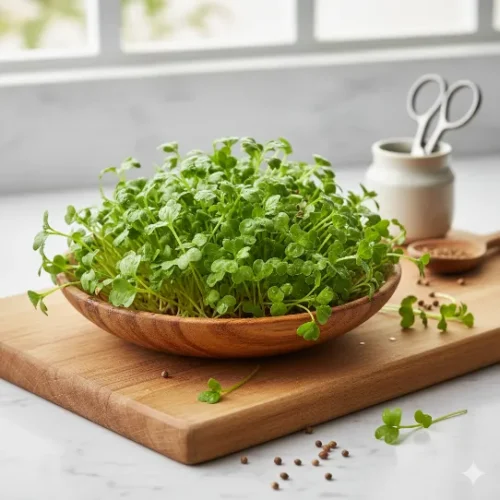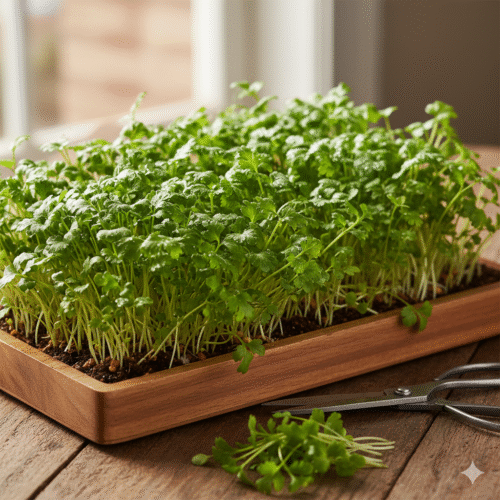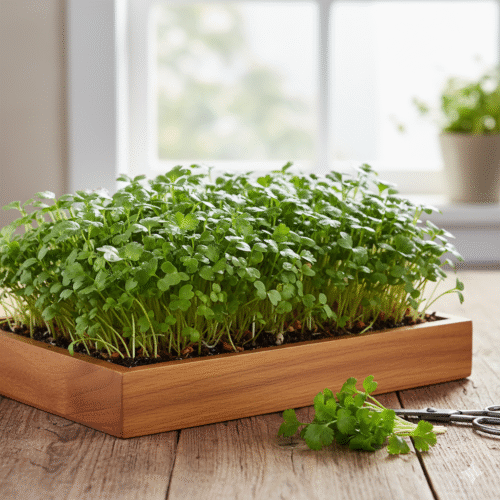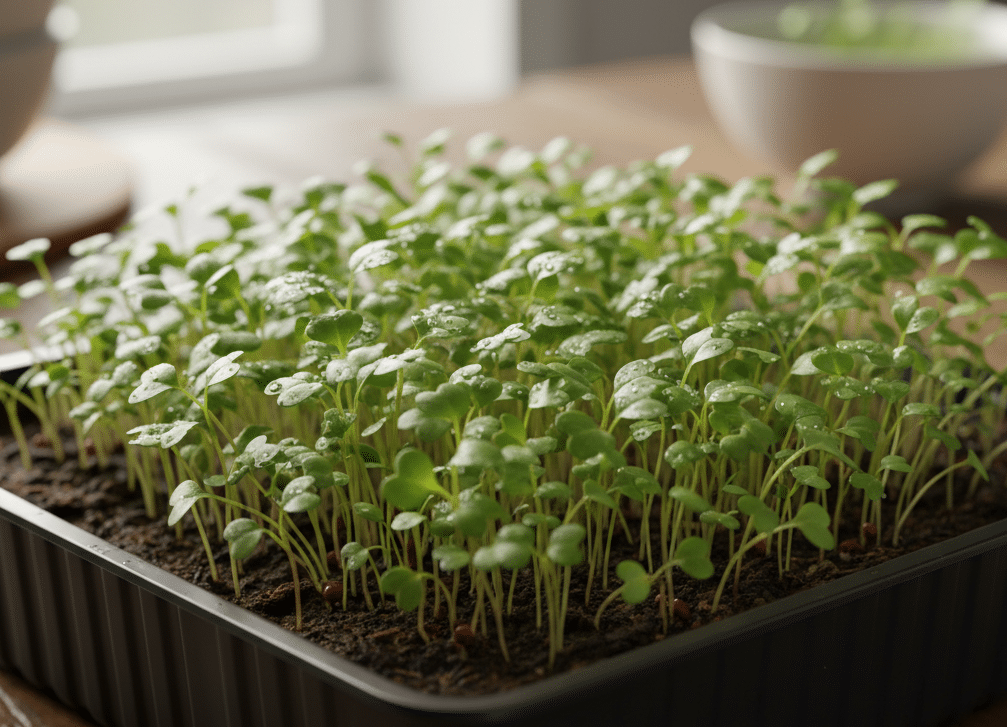Coriander microgreens (often called Cilantro microgreens) are not just a trendy garnish; they are nutritional powerhouses that offer a concentrated burst of vitamins, minerals, and beneficial plant compounds. As the tiny, tender seedlings of the mature coriander plant (Coriandrum sativum), they are harvested just after the first true leaves emerge, locking in a higher concentration of nutrients than their fully grown counterparts.
Table of Contents
What Are Microgreens?
Microgreens are young, edible seedlings of various vegetables and herbs, often called “youth crops”.

- Size and Appearance: They are typically 2 to 3 inches long. They consist of the first leaves that emerge after the seed germinates, along with their stem.
- Health and Demand: They are considered much healthier than their fully developed counterparts. They can contain up to five times more vitamins and carotenoids than mature plants and up to 40 times more nutrition than fruits and vegetables. Consuming just 50 grams daily can help fulfill nutritional needs. Due to their high nutritional value, demand is high in large restaurants and homes, making their cultivation profitable.
Suitable Varieties for Microgreens
A wide variety of plants can be grown as microgreens.

- Common Varieties: Turnip, radish, broccoli, groundnut, carrot, chard, lettuce, spinach, and basil.
- Good Choices for Farming: Coriander, mustard, onion, radish, mint, and mung bean (moong).
- Seeds Easily Available at Home: You can easily grow microgreens from kitchen seeds like coriander, fennel, mustard, fenugreek, and basil.
- Other Options: Dry peas, mung beans, sunflower seeds, broccoli, radish, spinach, beetroot, and kale seeds.
A Nutritional Powerhouse in Miniature
The defining characteristic of microgreens is their superior nutrient density. Scientific studies consistently show that coriander microgreens can contain significantly higher levels of certain vitamins and antioxidants compared to mature coriander leaves.

- Elevated Antioxidants: Microgreens, including coriander, are rich in polyphenols and carotenoids, which are potent antioxidants. These compounds help the body combat free radicals, reducing cellular damage and lowering oxidative stress, a key factor in chronic disease development.
- Vitamin Boost: Coriander microgreens are excellent sources of several essential vitamins, notably:
- Vitamin C: A powerful antioxidant that supports the immune system.
- Vitamin K: Crucial for blood clotting and essential for bone health.
- Beta-Carotene (Pro-Vitamin A): Studies suggest coriander microgreens can contain three times more beta-carotene than the mature plant. Beta-carotene is vital for vision health and a healthy immune response.
- Vitamin E: Another fat-soluble antioxidant important for immune function and cell protection.
How to Grow Microgreens
Microgreens can be grown in any season, but choosing season-appropriate crops is recommended.
1. Growing Medium and Containers
- Medium: The best medium is a good mixture of cocopeat and fertile soil. You can also use tissue paper, stacked and kept moist, as a soilless medium.
- Containers: Small containers about 3 to 4 inches deep or flat trays are suitable. Recycled items like shoe boxes or baskets can be used, but they must have proper drainage holes to prevent waterlogging and rotting.
2. Planting and Germination
- Spread 2 to 2.5 inches of soil/medium in the container.
- Spread the seeds evenly on the soil or moist tissue paper.
- If using soil, cover the seeds with a thin layer of soil and gently pat it down to ensure good contact.
- Keep the soil moist but not waterlogged. The seeds will typically germinate in two to three days.
3. Light and Water
- Light: Microgreens need only two to three hours of soft sunlight daily. Fluorescent lights can also be used to achieve good production.
- Watering (Irrigation): Until the seeds sprout, keep the soil uniformly moist; avoid overwatering. After germination, place the tray in the sun and spray water two to three times a day. Fresh tap water is beneficial.
4. Important Tips
- Do not use seeds treated with chemicals.
- Use good quality, chemical-free soil.
- Ensure the container has drainage holes to drain excess water.
5. Harvest
Microgreens are typically ready for harvest in about one week.
Key Health Benefits of Coriander Microgreens
The dense nutrient profile of coriander microgreens translates into several potential health advantages:
- गरीबों का प्रोटीन पाउडर: सहजन (Moringa Drumstick) – प्रकृति का वरदान!
- HMD Touch 4G: The ‘Hybrid Phone’ That Bridges the Digital Divide
- Firozabad का AQI-167: हवा में घुला ‘जहर’! 6 december 2025
- Aaj Ka Rashifal: Daily Rashifal, 6 december 2025
- OPPO A6x 5G: Just ₹12,499 | 6500mAh + 45w Fast Charging| Is It Worth?
- Supports Heart Health: The presence of powerful antioxidants and compounds like potassium can contribute to cardiovascular well-being. Potassium helps regulate blood pressure, while other components may help reduce levels of “bad” LDL cholesterol and triglycerides, thereby lowering the risk of heart disease.
- Aids Digestion and Gut Health: Coriander has a long history in traditional medicine as a digestive aid. The microgreens contain oils and compounds that can help soothe the digestive tract, potentially stimulating the secretion of digestive enzymes and reducing symptoms like bloating and discomfort.
- Potential Anti-Inflammatory Effects: Chronic inflammation is linked to various serious health conditions. The high concentration of anti-inflammatory antioxidants and phytochemicals, such as quercetin, in coriander microgreens helps the body reduce inflammation throughout its systems, promoting overall health.
- Boosts Immune Function: Packed with Vitamin C and other immune-supporting compounds, consuming coriander microgreens regularly can help strengthen the body’s natural defenses against illness.
- May Help Regulate Blood Sugar: Research on the mature coriander plant suggests that extracts may help lower blood sugar levels by promoting enzyme activity that helps remove sugar from the blood. While more human-specific studies are needed for the microgreen stage, the high concentration of bioactive compounds is promising for those managing Type 2 diabetes risk.
Coriander microgreens are a compact, delicious, and convenient source of exceptional nutrition. By concentrating the benefits of the mature plant into a tiny, easy-to-grow form, they offer a simple and effective way to enhance your diet with essential vitamins, minerals, and health-protecting antioxidants. Consider adding these powerful little greens to your plate for a daily dose of natural wellness.
- Best Website Speed Test
- JPG to PNG to WEBP converter
- Convert Any File Into PDF
- Facts About Tomatoes That You May Not Know
- Age Calculator
- Selena Gomez and Benny Blanco’s Marriage
Aaj Ka Rashifal agra amazing fact Aquarius Aries Astrology Cancer Capricorn Daily Rashifal environmental issue Exams fact firozabad Firozabad pollution Firozabad का AQI Gemini GK Notes for Exams health warning hindi horoscope important questions Indian railway industrial chimney kanpur Leo Libra Moderate air quality Pisces PM2.5 Poor AQI Rashifal Sagittarius Scorpio South Asia smog Taurus Unhealthy UP air pollution Uttar Pradesh Virgo अस्वस्थ ज्योतिष तथ्य फ़िरोज़ाबाद वायु प्रदूषण स्थिति और स्वास्थ्य
